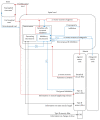Spasticity and its contribution to hypertonia in cerebral palsy
- PMID: 25649546
- PMCID: PMC4306250
- DOI: 10.1155/2015/317047
Spasticity and its contribution to hypertonia in cerebral palsy
Abstract
Spasticity is considered an important neural contributor to muscle hypertonia in children with cerebral palsy (CP). It is most often treated with antispasticity medication, such as Botulinum Toxin-A. However, treatment response is highly variable. Part of this variability may be due to the inability of clinical tests to differentiate between the neural (e.g., spasticity) and nonneural (e.g., soft tissue properties) contributions to hypertonia, leading to the terms "spasticity" and "hypertonia" often being used interchangeably. Recent advancements in instrumented spasticity assessments offer objective measurement methods for distinction and quantification of hypertonia components. These methods can be applied in clinical settings and their results used to fine-tune and improve treatment. We reviewed current advancements and new insights with respect to quantifying spasticity and its contribution to muscle hypertonia in children with CP. First, we revisit what is known about spasticity in children with CP, including the various definitions and its pathophysiology. Second, we summarize the state of the art on instrumented spasticity assessment in CP and review the parameters developed to quantify the neural and nonneural components of hypertonia. Lastly, the impact these quantitative parameters have on clinical decision-making is considered and recommendations for future clinical and research investigations are discussed.
Figures


References
-
- Lance J. Symposium synopsis. In: Feldman R. G., Young R. R., Koella W. P., editors. Spasticity: Disordered Motor Control. Chicago, Ill, USA: Yearbook Medical; 1980. pp. 485–494.
Publication types
MeSH terms
LinkOut - more resources
Full Text Sources
Other Literature Sources
Medical
Miscellaneous

